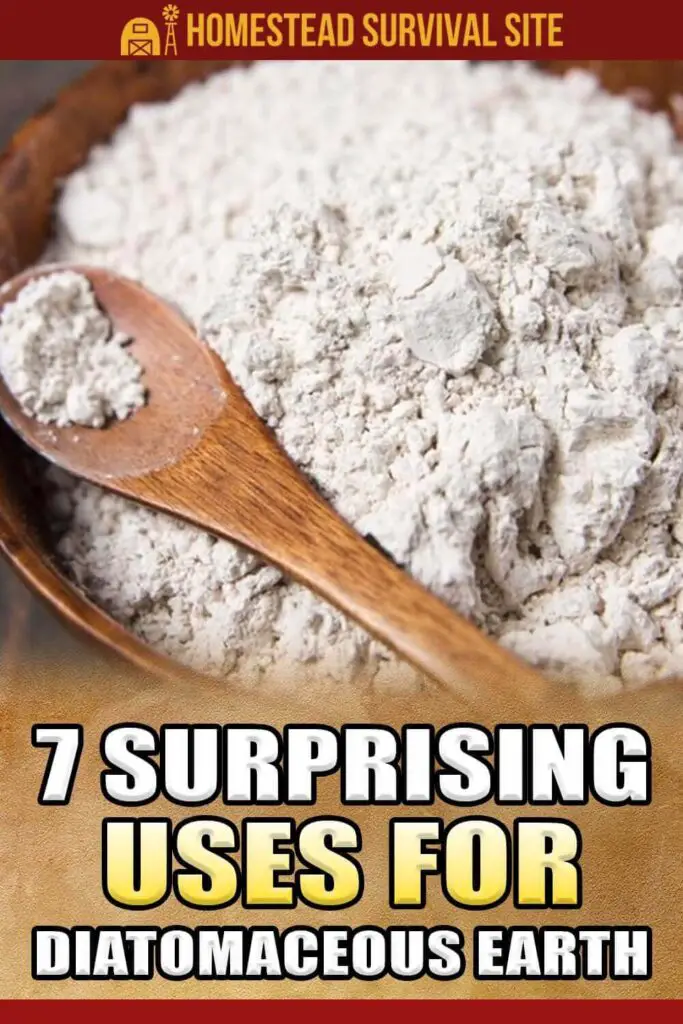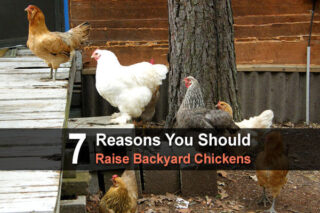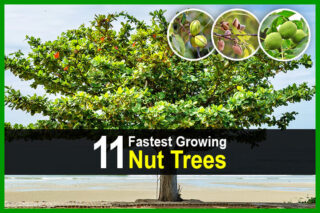Estimated reading time: 7 minutes
Disclaimer: I am not a medical doctor and nothing in this article should be taken as medical advice. Please talk to your doctor before using any of the herbs and/or remedies mentioned in this article.

So what exactly is diatomaceous earth (DE)? Well, it's the fossilized remains of small aquatic organisms that are usually found in the bottom of rivers, oceans, and lakes. These little organisms are called Diatoms.
To create DE, these Diatoms are ground up to create a smooth food grade powder that is easy to use in a multitude of ways, from skincare to pest control.
What makes DE such a miracle worker? It’s all about its unique and natural chemical makeup that is super rich in nutrients and minerals! Heavy in silica (33%) with calcium (19%), magnesium (3%) and other healthy minerals, this powdery sediment is a versatile problem solver.
Want to save this post for later? Click Here to Pin It On Pinterest!
Uses for Diatomaceous Earth
Here are some of the most popular uses for diatomaceous earth.
1. Non-Toxic Pesticide
DE is totally plant-friendly, yet it's a ruthless pest killer. Pinworms, bed bugs, ants, fleas and any most other unwanted soil critters die almost instantly when they come in contact with DE. However, diatomaceous earth is still extremely safe (and even healthy) for mammals, humans, and pets.
2. Livestock Feed
Farmers and big livestock feed companies mix DE into their feed batches. Diatomaceous Earth feed helps pigs, cows, chickens and other farm friends remain free of parasites and worms.
3. Food Storage
Absorb moisture, avoid mold, and deter parasites & bugs. Adding Food Grade DE to your grains, beans, and other stockpile food is a must for long-term assurance.
4. Gorgeous Hair & Nails
Silica and calcium restore depleted hair to fight balding, breaking, and chipping. Add a teaspoon of DE to your yogurt, cereal or smoothie every morning to take your hair and nails from brittle to brilliant.
5. Detox Supplement
Diatomaceous Earth is a natural detoxifying agent! Skip the super expensive name brand supplements and choose a natural supplement with proven results. DE detoxes the liver, colon, intestines, and blood stream by eliminating toxins & metals for a thorough cleanse that is safe for everyday use.
6. Anti-Aging Compound
Diatomaceous Earth carries a totally natural electrical charge that attracts and eliminates free radicals in your system. Free Radicals are capable of damaging the DNA and proteins in your body which leads to early aging. Early aging can be seen cosmetically with wrinkled skin and hair loss, as well as internally with joint pain and even damage to brain tissue. A teaspoon a day goes a long way and could potentially add years on to your life.
7. Stronger Bones & Teeth
As we age, the calcium that fortifies our bones and teeth begins to diminish. DE does a fabulous job of replenishing bones and teeth with silica. This silica is absorbed into our bloodstream and then deposits calcium and iron into our bones and teeth. DE not only prevents breaking bones and chipping teeth but also speeds up the repair time for broken bones!
Food Grade Diatomaceous Earth vs. Pool Grade Diatomaceous Earth
When you’re planning to buy DE, you will find an abundant supply and market for Food Grade Diatomaceous Earth. Kid-friendly, pet-friendly, and plant friendly, this product is in huge demand.
The lesser used version of DE is Pool Grade. This version of DE is treated with very high heat that turns the naturally occurring silica element into crystalline silica which is harmful to humans. However, Pool Grade DE can be used for (you guessed it) the pool! This grade of DE filters algae and works well with chlorinated water. That’s it. That’s all.
Warning: Before using diatomaceous earth, I recommend wearing a dust mask. Although DE is relatively safe, if you breathe in too much, it can lead to Pulmonary Silicosis with scarring of the lungs, coughing, and shortness of breath.
How to use DE in the Home
- Fleas in your carpet.
- Bed Bugs in and under your bed.
Step 1: Vacuum or sweep over the infested area (this will uproot the bugs from their hiding spots and remove debris that may be used to protect them).
Step 2: Use your hand or a powder duster to sprinkle a fine layer of DE over the surface.
Step 3: Let the DE sit for 12 hours and then vacuum again.
Repeat the vacuum-spray-vacuum process 1x per week for 4 weeks.
How to Use DE for Plants
- Control Leaf-Eating & Egg-Laying Bugs
Step 1: In a plant sprayer, mix 1 cup of diatomaceous earth per every ½ gallon of water (or 2 cups per gallon).
Step 2: Spray the leaves, flowers, and stems of your plants until moist.
Step 3: Repeat 2x per week.
Applying DE directly to your plants is one of the most efficient ways to keep your leaves and flowers from being demolished while still making your plants safe for humans to eat!
How to Use DE for Soil
- Eliminating exposure to pinworms for kids.
- Killing fleas, ants, and other unwanted bugs.
Step 1: Use a garden cultivator or rake to dredge up the soil, mixing the dry top layer with the moist under-earth.
Step 2: Fill a dust applicator with DE.
Step 3: Lightly cover the infested area (or area that you don’t want to become infested) with a light dusting of DE.
Bonus Step: If your soil is heavily infested, repeat steps 2 & 3.
Diatomaceous earth is effective the moment it comes in contact with pests. These critters will be broken down and become one with the earth. No need to uproot your plants or refresh your soil.
How to Use DE for Food Storage
- Bags or buckets of grains, beans, and other loose food.
Step 1: Spread a thin layer of DE on the base of your bucket, bag, or container.
Step 2: Pour 4 inches of food over the layer.
Step 3: Repeat steps 2 & 3 until the container is full, with a final DE layer on top.
Step 4: Seal the container and shake it so that the DE spreads out. Store.
When you are ready to eat, no need to rinse the DE from the grain (remember, it’s good for you), but you can if you want.
How to Consume DE for Human Health
Step 1: Mix 1 teaspoon with water or smoothies to drink, or sprinkle one teaspoon on your cereal, soup, or yogurt.
Repeat 1x per day for long-lasting health and beauty benefits.
What Does DE Taste Like?
I’m sure all this talk of drinking and eating DE has you wondering if DE will change the flavor of your food. The answer is no. DE is odorless and tasteless. The only time you will notice DE is when you’ve mixed it into your water to drink which adds a slight texture to your water.
Tips on How to Store DE
- Keep your DE dry.
- Keep it room temperature or cool.
- Do not store it in a fridge with open containers (or else your DE will absorb those scents).
So there ya have it. Diatomaceous Earth is not only a game-changer but a life changer! I’m never one to slap a buzzy-worthy title such as ‘miracle worker’ or ‘problem solver’ on any product… but in this case, DE is 100% a miracle-working problem solver that everyone should have in their pantry.
Keep a big resealable tub like this 4lb bucket for easy storage and carry. Or consider splitting your DE in half with a resealable container on the kitchen counter and the other half in the garage for garden use.
Warning: Applying all of these steps and methods will result in superhuman effects. You will have healthier skin, nails, and immune system while living in a pest-free home and eating an abundant supply of fresh fruits and veggies from the garden. Don't say I didn't warn you. 😉
Like this post? Don't Forget to Pin It On Pinterest!












WOW!! This was an informative article, thanks.
Is it important for people and pets NOT to inhale the dust from the DE when applying on your carpet? Or am I misremembering that? I had thought I had read it was not good for the lungs . . .
Yes, it can irritate the lungs. You don’t necessarily need a mask while handling it, but I suppose it couldn’t hurt.
Hello. Bew member here, I just bought a 50lb bag of diamataceous earth from my local feed & garden store it says food & chemical grade on it, it is a gray color can I use it for us people?, it does have pics of all kinds of animals & veggies & flowers on the bag, just wondering if there is another step I need to take to use it for me or can I go ahead as is?
If it says “food grade” then it should be safe to consume.
I know a guy who has diverticulosis. Two days after he started using Food Grade DE, he was in the hospital w/full-blown diverticulitis. Always ask your doc, first!!
These are all good uses for DE, I would however State that it’s a good idea to wear a dust mask when handling DE, as silica is the prime component, and it does collect in the lungs, and over time can lead to Pulmonary Silicosis, a particularly nasty COPD variant.
DE is a very useful tool, but like many other tools, it needs to be handled with care and caution.
That’s a good point. I added a note in the article recommending that people wear a dust mask.
I bought a five lb. bag of DE about ten years ago but for some reason, I cannot remember, I stopped using it. It is still in the original bag sealed. My question is is it still good to use it as a food grade. I bought it at a health food store and it was very pricy.
I need to know if after having the DE over ten years ago, is it still good as a food grade.
Yes, if it has remained sealed and dry, it will still be fine to use. Wear a mask since the dust is not good for your lungs, and remember that DE will kill ALL insects without distinction. So use it sparingly in the yard/garden to protect our pollinators (which are necessary to food production).